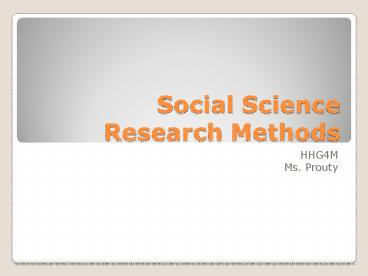Social Science Research Methods PowerPoint PPT Presentation
Title: Social Science Research Methods
1
Social Science Research Methods
- HHG4M
- Ms. Prouty
2
Introduce yourself to Social Science Research
- Read What the experts say on pg.5. Change
creates new research opportunities. Identify
something from the article that could be a topic
of social science research. 1 - Summarize the 8 social science research methods.
2 - Define scientific method hypothesis
quantitative research qualitative research. 1 - Make note of The Research Process on page 11. 2
3
Cont.
- 5. Explain the terms primary and secondary
research 2 - 6. How can one identify opinion verses fact? 3
- 7. Take the Quick Quiz on page16 3
- 8. Summarize Organizing Your Research
Presentation found on page 17 4 - 9. What is informed consent? Why is it important
to your research? 3
4
The Process
5
Defining the Question
- Stage 1
6
Defining the Question
- Through brainstorming and preliminary research,
identify a question that will focus your inquiry.
- Focusing means going from broad to more narrow.
- Research questions should be open-ended (you
cannot answer with a simple yes or no).
7
Locating Information
- Stage 2
8
- You can gather data using primary and/or
secondary research and/or sources.
Primary Secondary
Research The researcher is the first person (primary) to view the research. The researcher performs the research. You will be conducting primary research when you conduct an interview or a survey. Researching data and information already collected by another researcher.
Source An original document or account that is not about another document or account. Interpretations of primary sources, such as journal articles or books about another book, topic, photograph, etc.
9
- One or more of the eight research methods could
be used. - Observation
- Participatory Observation
- Personal Interview
- Phenomenology
- Survey
- Historical Research
- Official Statistics
- Review of Literature
- Which methods are primary research methods and
which are secondary research methods?
10
Selecting a Research Method
- Observation
- Participatory Observation
- Personal Interview
- Phenomenology
- Survey
- Historical Research
- Official Statistics
- Review of Literature
- Which is the best method to test your hypothesis?
- Does your research question lead you to a
particular research method?
11
Where can I find resources?
- Your first step
- http//homer.ugdsb.on.ca/norwell/library.aspx
- What now?
- Use Google wisely, and with caution
- Read Wikipedia for a backgrounder, but then go to
Wikipedia's sources
12
Evaluating Information
- Stage 3
13
Checking for Bias
- Bias is motivated by a lack of objectivity, or a
prejudiced perspective on a topic. Researchers
may be pursuing a specific, desired outcome
through biased research practices. The
researchers personal beliefs, attitudes,
interests, and values can influence their
research processes. - Bias can be evident in the use of language,
especially in discussions that refer to
14
Types of Bias
- people with disabilities
- People with disabilities should be referred to
with respect. - Avoid texts that refer to the individual with
labels that imply that the person is entirely
characterized by the disability, that the person
is ill, or that exaggerate the limitations of the
disability. Rather, look for language that
acknowledges the individual as a contributing
member of society, rather than a dependent
patient or client.
15
Types of Bias cont.
- racial/ethnic groups
- When racially and ethnically diverse people are
identified, writers need to be as accurate as
possible with culturally relative, current
terminology that is acceptable to the group.
Researchers must also be aware of evaluating a
group against their own culture, and creating an
ethnocentric bias.
16
Types of Bias cont.
- gender
- The APA recommends non-sexist language, unless it
is relevant to the discussion to refer
specifically to minority or special-interest
groups.
17
Types of Bias cont.
- heterosexism.
- Acceptable terminology to avoid heterosexual bias
includes sexual orientation to refer to the
sexual relationships of lesbians, gay men, and
bisexual people. - The terms lesbians and gay men are preferable
to homosexual as it is more specific and avoids
negative connotations that have become associated
with the latter term.
18
How to Read an Academic Article
- SKIM Skim the text, noting the subheadings of
sections. - HIGHLIGHT Read through the resource or article,
highlight important information and take brief
notes. - MAIN POINTS In your own words, write down the
main points from each section of the resource or
article. - SUPPORT POINTS Write down the key supporting
points for the main topics of the resource or
article.

